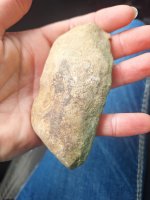G.A.P.metal
Gold Member
- Jul 5, 2010
- 6,468
- 7,387
- 🥇 Banner finds
- 1
- Detector(s) used
-
Deus, 11" Low Freq. , 9" X35 Coils, MI 6 Pointer...
Land or Sea Pointer
King Of Spades 40" KS-D SA and 40" KS-S-SA
L
- Primary Interest:
- Relic Hunting
I just got a new Tek Omega any users here...how do you like it 





